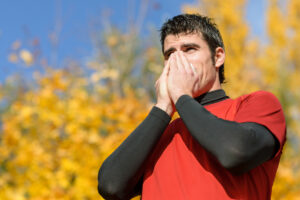Fall Allergies

As we approach the end of Summer in the coming month, many individuals will begin to experience an increase of their allergy symptoms. In the world of allergies, these symptoms are considered Fall allergies. Typically in the Washington, DC, Northern Virginia, and Maryland metropolitan area, ragweed begins to pollinate in mid-August. The release of ragweed pollen into the air can be dreadful for many ragweed-allergic individuals. As the ragweed pollen count climbs through the rest of August and throughout most of September, the allergic rhinitis (i.e., hay fever), allergic conjunctivitis (i.e., eye allergies), and/or asthma symptoms of patients with ragweed allergy usually increase proportionally. The end of ragweed season coincides with the first frost which is usually in late October in the Washington, DC metro area. Approximately 10% of the population in the U.S. has a ragweed allergy. There are 17 species of ragweed in North America. Each ragweed plant produces about 1 billion pollen grains per season. The only state in the U.S. without ragweed is Alaska. Ragweed is more common in the Midwest and eastern U.S. Warm temperatures and increased humidity are factors that augment the release of ragweed pollen.
The classic symptoms that people with ragweed allergy experience may include runny nose, nasal congestion, post-nasal drip, sneezing, itchy nose, itchy throat, sinus congestion, sinus pain, headaches, snoring, itchy eyes, watery eyes, puffy eyes, redness of the eyes, chest tightness, coughing, wheezing, and/or shortness of breath. Ragweed may also increase the likelihood of sinus infections (i.e., sinusitis) in some susceptible individuals.
An itchy mouth, throat and/or lips can occur in some ragweed-allergic individuals after eating certain ragweed-associated foods. The foods that may be associated with ragweed pollen allergy include banana, melon (e.g., watermelon, cantaloupe, honeydew), white potato, chamomile tea, cucumber, zucchini, artichoke, sunflower seeds, and dandelion. In general, no other allergy symptoms beyond an itchy mouth, throat, and/or lips occur. This condition is called oral allergy syndrome or pollen-food allergy syndrome. The syndrome in general is caused by allergens in foods that are derived from plants. Furthermore, these foods are usually raw or uncooked fruits, vegetables, and nuts. Only foods that come from plants can cause the syndrome. Extra caution needs to be taken into account where nuts cause symptoms because many individuals can have nut allergies that are not associated with plants which may be life-threatening. Ironically, when the fruit or vegetable is cooked or canned, the protein is denatured and destroyed which usually prevents the allergic reaction from occurring. In most instances, individuals can tolerate cooked and/or canned fruits and vegetables.
In addition to ragweed as a cause of Fall allergies, molds, dust mites, pet dander, and cockroaches are also major sources of Fall allergies. Molds are perennial in nature and occur naturally in both indoor and outdoor settings. Washington, DC is notorious for its mold content as it was built on a swamp. In addition, the amount of mold tends to be worse in the Washington, DC metro area in the Spring with all of the rain and in the Fall with the increased amount leaf mold from all of the moldy wet leaves on the ground. Avoiding damp places, not raking leaves, and keeping the humidity below 50% may help in minimizing one’s exposure to molds. Dust mites are indoor allergens and are a problem for allergy sufferers year-round. Dust mites tend to live in bedding (i.e., mattresses, pillows, box springs), carpeting, and upholstered furniture. Covering one’s pillows, mattresses, and box springs with allergy-proof encasings and limiting stuffed animals and dust gathering objects has shown to help minimize one’s exposure to dust. Pets (e.g., cats, dogs, rabbits) can obviously cause allergy symptoms in pet-allergic individuals. Avoiding contact with pets, keeping a pet out of the bedroom, and washing the pet can all help reduce one’s exposure to pets. Cockroaches are potent allergens that cause perennial symptoms due to their ubiquitous nature. They are notable in the field of allergy and immunology for being a leading aggravating factor of childhood asthma in inner city populations. Extermination of cockroaches by professional exterminators can help reduce one’s exposure to cockroaches.
The board certified allergy specialists at Black & Kletz Allergy have been diagnosing and treating allergies, asthma, sinus conditions, and immunological disorders for more than 5 decades. Black & Kletz Allergy has 3 convenient locations in the Washington, DC metro area with offices in Washington, DC, McLean, VA (Tysons Corner, VA), and Manassas, VA. We offer on-site parking at each location and the Washington, DC and McLean offices are Metro accessible. There is a free shuttle that runs between our McLean, VA office and the Spring Hill metro station on the silver line. Please call us today to make an appointment at the office of your choice. Alternatively, you can click Request an Appointment and we will respond within 24 hours by the next business day. The allergy doctors at Black & Kletz Allergy pride themselves in delivering the highest quality allergy care in the Washington, DC metropolitan area in conjunction with providing an excellent patient experience in a friendly and pleasant environment.
